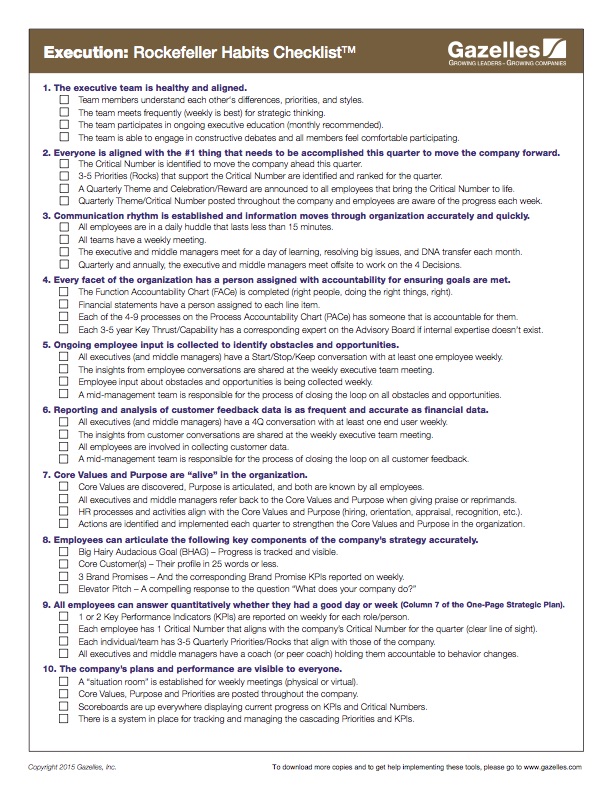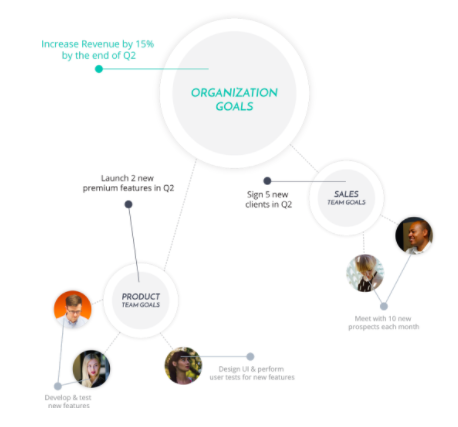If your company’s still scaling, there’s a good chance you’ve read Scaling Up, by Verne Harnish, and you are interested in mastering the Rockefeller habits. More than 40,000 business leaders have reportedly relied on it to grow their businesses, and with good reason. This book is one of this century’s most important for startups, CEOs and entrepreneurs.
About 145 pages into Verne Harnish’s popular book is a checklist of everyday functions that should be on autopilot:
[Source: Gazelles.com]
This checklist is where the concepts in Harnish’s book really become actionable. The theory is that once your management team masters these ten critical components, the transition from startup to success story will accelerate as teams align, communication becomes rhythmic and people are driven by purpose and passion.
In this post, we’ll take a look at the three pillars of this checklist. If you stick with me to the end, you’ll learn several methods that make it immeasurably easier to master the Rockefeller Habits and grow your business:
- Making Goals Measurable
- Establishing Effective Standups
- Making Team Reporting Rhythmic
First, a brief history of the Rockefeller Habits and why they’re relevant to any growing organization.
What are the Rockefeller Habits?
Harnish created the “Rockefeller Habits” based on leadership principles used by John D. Rockefeller, the famous founder of Standard Oil who’s often regarded as the most successful business person in U.S. history.
The habits are deemed essential for virtually any scaling organization, and in particular for ambitious entrepreneurial firms seeking hyper-growth and industry dominance.
As Forbes writer Scott Allison put it:
“Those are companies where a month or a quarter is more like a year for a regular business. When you’re growing that fast you need some guiding principles or rules to run by.”
Those guiding principles come to life in Harnish’s checklist. It provides a framework for routinizing important practices that together can align an entire organization around a common mission and vision.
If you haven’t read Harnish’s book, I highly recommend it. In addition to key insights for employee engagement and customer success, you’ll come away with greater confidence in clearly communicating your company’s vision and goals.
As you work toward conquering the checklist, there are several techniques that make it easier to adopt the most important habits.
Pillar 1: Goal Tracking
The Habit: Everyone is aligned with the #1 thing that needs to be accomplished this quarter to move the company forward.
Before an organization can even begin to think about building an industry-dominating business, its leaders need to define the specific, attainable goals that will help the company get there.
This step is important enough that it’s placed at the top of Harnish’s checklist, just under “the executive team is healthy and aligned,” and is the driving force behind virtually all other priorities.
So, how do you get it right? How do you get individuals and teams aligned around that one all-important milestone that’s virtually guaranteed to move the company forward? One method, in particular, makes this process exponentially easier: OKRs.
Mastering the Rockefeller Habits with OKRs
If you’re not using OKRs in quarterly planning, now is a great time to start. The acronym stands for “objectives and key results,” a proven method that helps teams reach goals faster.
Executives at Google credit the OKR process for fueling the company’s exponential growth, as do contemporaries at Intel, Adobe, Dropbox, and many others.
You can start tracking your OKRs with Jell by signing up for a 14-day free trial.
Setting objectives and key results is a concrete way to rally teams around big, overarching goals by making them relevant and achievable at the personal level.
If the #1 thing that needs to happen this quarter is “improve the pipeline,” team members can tackle more concrete OKRs such as “increase qualified traffic by 10%” and “increase signup conversion rate by 5%.”
It’s much easier to rally teams around a common mission when you habitualize the process of personalizing quarterly goals.
OKRs are equally effective for all kinds of issues faced by the scaling business, from increasing revenue to expanding product functionality. Once you’ve defined your single theme for the coming quarter, start building out OKRs that empower employees to rally around your top quarterly goal for the company.
Before long, the “3-5 Priorities (Rocks) that support the Critical Number” will be identified and ranked for the quarter.
Better yet, by routinizing OKRs you’ll also master another key habit on Harnish’s checklist:
The Habit: All employees can answer quantitatively whether they had a good day or week.
OKRs provide the necessary framework for:
- Reviewing one or two key performance indicators (KPIs) each week per person.
- Ensuring each employee has a clear line of sight to the company’s quarterly theme with their own personal “one critical number”.
- Securing several key quarterly priorities within each team.
Pillar 2: Daily Standup
The Habit: Communication rhythm is established and information moves through organization accurately and quickly.
The key to mastering this habit, according to the checklist, is to ensure that all employees are in a short daily huddle that lasts less than 15 minutes.
Most companies will recognize this as the daily standup—the approach that gained popularity after military leaders used it to minimize battlefield distractions. Traditionally, the standup occurs in a room where each person has a few minutes to update everyone else on their current activities. The team remains standing to encourage shorter meetings as key issues are addressed in rapid succession, saving hours of time.
The problem with standup meetings is that, while they do save time, they can sometimes interrupt workflows and cause confusion—particularly at the fast-moving organization.
Scheduled standups often distract people from highly productive activities (particularly if they occur in the morning; see #3 in this post) and leave behind no official log of activity in their wake.
Rather than moving quickly and accurately, information is log-jammed as people mentally check out of the meeting and then quickly move on to the next tasks on their to-do lists.
There’s a much more impactful way to establish an effective communication rhythm:
Simply move your daily huddle online.
Mastering the Rockefeller Habits with Online Standups
Even if your organization is not decentralized and your employees don’t work remotely, there are some big benefits to conducting online daily standups.
By moving standups online, you’ll automatically weave them into daily routines without interrupting workflows. Team members can provide their updates at the time that’s most convenient and productive for them.
What’s more, the activities are quickly and accurately recorded. Which brings me to the next Rockefeller habit within this pillar…
The Habit: The company’s plans and performance are visible to everyone.
When you record daily standups in an online platform, company-wide plans and progress become immediately accessible to everyone at the organization. Questions can be answered faster and problems resolved sooner. By archiving daily status updates, you can put a record of past activities at managers’ and colleagues’ fingertips that makes it easier to track and manage progress and priorities.
Pillar 3: Team Reporting
The Habit: Ongoing employee input is collected to identify obstacles and opportunities.
Mastering the Rockefeller Habits with Team Reporting
Once you’ve established a rhythm with goal tracking and online standups, it’s time to move on to a centralized reporting structure. Habitualized team reporting allows you to get the information you need from all members of your organization on a regular basis.
For example:
A weekly recap of progress, plans and problems can help you determine team members’ biggest accomplishments as they relate to your organization’s current priorities.
Monthly updates shed light on how each team is driving the organization toward your #1 quarterly theme. Communicating monthly milestones, goal progress, and other information can help you stay ahead of critical issues—like risks that should be made visible or whether you’re maximizing current capacities.
By aggregating and reporting employee input on obstacles and opportunities on a weekly and monthly basis, you’ll stay ahead of important issues that can be the determining factors in organization-wide growth.
In Conclusion:
Mastering the Rockefeller Habits can have a big impact on how well teams align around a common mission as a company scales. Harnish’s checklist creates a clear path to routinizing those habits.
Leaning on the three pillars of successful team management—goal tracking, daily standups and team reporting—can help speed up the sometimes lengthy process and make things go much more smoothly.
If you’re eager for more advice on how to align teams and put the checklist into action, check out these additional posts:
How to Set Objectives and Key Results
The Science of Productive Team Meetings: Quality Over Quantity
Tracking Company Goals with Jell Just Got Better
Additionally, sign up for your team’s free trial of Jell. Once your two-week trial is up, we’ll only charge $1-$2 per employee per week to keep your team focused on getting important tasks done, staying on track, and meeting OKRs.




